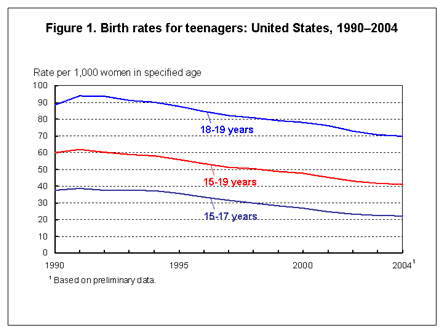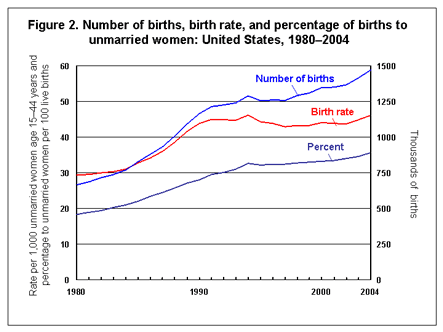Preliminary Births for 2004
by Brady E. Hamilton, Ph.D.; Stephanie J. Ventura, M.A.; Joyce A. Martin, M.P.H.; and Paul D. Sutton, Ph.D.; Division of Vital Statistics
This report from CDC’s National Center for Health Statistics summarizes the 2004 preliminary births and birth rates for the United States. A forthcoming report will highlight selected 2004 preliminary maternal and infant health birth data for the United States. A report which includes both demographic and health characteristics of births as well as State-based preliminary 2004 data is in preparation. Key findings, illustrated in Tables 1–4 pdf icon[PDF – 22 KB] and Figures 1 and 2, show:
- Number of births up, crude birth rate down, and general fertility rate up slightly in 2004. There were 4.1 million births in 2004, nearly 1 percent more than in 2003 (Tables 1 and 2). Births increased for Hispanic, Asian or Pacific Islander (API) and American Indian women, remained essentially unchanged for non-Hispanic black women, and decreased for non-Hispanic white women. The 2004 crude birth rate (14.0 births per 1,000 total population) was 1 percent lower than in 2003. The general fertility rate in 2004, however, was up slightly from the rate in 2003, to 66.3 births per 1,000 women age 15–44 years.
- Childbearing by unmarried women reached a record high of almost 1.5 million births in 2004, up 4 percent from 2003 (Tables 1 and 4; Figure 2). More than 4 in 5 births to teenagers were nonmarital (Table 4). Over half of births to women in their early twenties and nearly 3 in 10 births to women aged 25–29 were to unmarried women. In 2004, 35.7 percent of all births were to unmarried women and the percentages increased for all age, race, and Hispanic origin subgroups. The birth rate increased 3 percent to 46.1 births per 1,000 unmarried women 15–44 years.
- Teenage birth rates declined again in 2004, but at a much slower pace than observed since the declines started after 1991 (Tables 2 and 3; Figure 1). The U.S. rate in 2004, another record low for the Nation, was 41.2 births per 1,000 females aged 15–19, 1 percent lower than in 2003, and 33 percent lower than the rate of 61.8 in 1991 (1). Rates declined modestly for teenagers 15–17 and 18–19, but increased slightly for ages 10–14. Rates fell 2 to 3 percent for non-Hispanic white and non-Hispanic black teenagers, and were unchanged for American Indians, Hispanics, and Asian or Pacific Islanders. The number of births to teenagers increased very slightly in 2004.
- Childbearing by women in their early twenties showed a decline. The birth rate for women aged 20–24 years decreased 1 percent, to 101.8 births per 1,000 women in 2004, the lowest rate ever reported. The rate for women aged 25–29 years was essentially unchanged in 2004 (115.5), but remained the highest rate amongst the age groups.
- Births to older women continue to increase. From 2003 to 2004, the birth rate for women aged 30–34 years increased slightly (less than 1 percent) while the rate for women aged 35–39 years rose by 4 percent. The birth rate for women 40–44 years increased 3 percent, to 9.0, and the rate for women aged 45–49 years increased in 2004 to 0.6 births per 1,000 women.
- Total fertility rate up slightly in 2004. The total fertility rate (TFR) increased slightly to 2,048.5 in 2004, from 2,042.5 in 2003 (tabular data not shown) (Table 1). The TFR summarizes the potential impact of current fertility patterns on completed family size to estimate the average number of births that a hypothetical group of 1,000 women would have over their lifetimes. The TFR by race and Hispanic origin increased for only two groups in 2004: API and Hispanic women, which rose 1 percent each (Table 1). The TFR for non-Hispanic black and non-Hispanic white women fell between 2003 and 2004 and the rate for American Indian women was essentially unchanged.
Technical Notes
Nature and source of data
Preliminary data for 2004 are based on a substantial proportion of births for that year (99.1 percent). The data for 2004 are based on a continuous receipt and processing of statistical records through May 25, 2005, by the Centers for Disease Control and Prevention’s National Center for Health Statistics (NCHS). NCHS receives the data from the States’ vital registration systems through the Vital Statistics Cooperative Program. In this report, U.S. totals include only events occurring within the 50 States and the District of Columbia. Detailed information on reporting completeness and imputation procedures may be found in the “Technical Appendix” of Vital Statistics of the United States, 2003, Natality (2).
To produce the preliminary estimates shown in this report, records in the file were weighted using independent control counts of all 2004 births by State of occurrence. Detailed information on weighting is available elsewhere (3). Detailed information on the reliability of estimates also may be found elsewhere (2).
Hispanic origin of mother
Race and Hispanic origin are reported separately on the birth certificate. Data shown by race (i.e., American Indian or Alaska Native and Asian or Pacific Islander) include persons of Hispanic or non-Hispanic origin, and data for Hispanic origin include persons of any race. Data shown for Hispanic persons include all persons of Hispanic origin of any race. Data are shown separately for non-Hispanic white women because there are substantial differences in childbearing patterns between Hispanic and non-Hispanic white women.
Single, multiple, and bridged race of mother
The 2003 revision of the U.S. Standard Certificate of Live Birth allows the reporting of more than one race (multiple races) for each parent (4). Information on this change is presented in a recent report (1).
In 2004, multiple race was reported on the revised birth certificates of Florida, Idaho, Kentucky, New Hampshire, New York State (excluding New York City), Pennsylvania, South Carolina, Tennessee, and Washington, as well as on the unrevised certificates of California, Hawaii, Michigan, Minnesota, Ohio, and Utah. Data from the vital records of the remaining 35 States and the District of Columbia are based on the 1989 revision of the U.S. Standard Certificate of Live Birth that follows the 1977 Office of Management and Budget (OMB) standard, allowing only a single race to be reported (5–7).
In order to provide uniformity and comparability of the data during the transition period, before all or most of the data are available in the new multiple race format, it was necessary to “bridge” the responses of those who reported more than one race (multiple race) to one, single race (see “Population denominators”). Information on the processing and tabulation of data by race is presented in a recent report (1).
Marital Status
Information on the national estimates of births to unmarried women (i.e., methods of determining marital status) and the computation of the preliminary birth rates for unmarried women are presented elsewhere (3).
The birth rate for unmarried women for 2004 is estimated on the basis of population distributions by marital status provided by the U.S. Census Bureau as of March 2004 applied to the national population estimates as of July 1 (8–10). Both population files are 2000 Census- based.
The nonmarital birth rate shown here for 2004 thus differs from those published by NCHS in the annual final reports, which are based on populations estimated from 3-year averages of the marital status distributions, rather than a single year as shown here (9).
Population estimates for a single year are not an adequate basis for computing age-specific birth rates for unmarried women—these rates are available only in reports based on final data.
Population denominators
Birth and fertility rates shown in this report for 2003 and 2004 are based on population estimates based on the 2000 Census, as of July 1, 2003, and 2004. These population estimates are available on the NCHS Web page (8,11). The production of these population estimates is described in detail in a recent report (1).
References
- Martin JA, Hamilton BE, Sutton PD, et al. Births: Final data for 2003 pdf icon[PDF – 3.9 MB]. National vital statistics reports; vol 54 no 2. Hyattsville, MD: National Center for Health Statistics. 2005.
- National Center for Health Statistics. Technical Appendix. Vital statistics of the United States, 2003, vol I natality. U.S. Department of Health and Human Services, Centers for Disease Control and Prevention, National Center for Health Statistics. Hyattsville, MD.
- Hamilton BE, Martin JA, Sutton PD. Births: Preliminary data for 2003 pdf icon[PDF – 861 KB]. National vital statistics reports; vol 53 no 9. Hyattsville, MD: National Center for Health Statistics. 2004.
- National Center for Health Statistics. 2003 revision of the U.S. Standard Certificate of Live Birth pdf icon[PDF – 143 KB]. 2003.
- Office of Management and Budget. Revisions to the standards for the classification of Federal data on race and ethnicityexternal icon. Federal Register 62FR58781-58790. October 30, 1997.
- National Center for Health Statistics. Report of the Panel to Evaluate the U.S. Standard Certificates and Reports pdf icon[PDF – 1.9 MB]. National Center for Health Statistics. 2000.
- Office of Management and Budget. Race and ethnic standards for Federal statistics and administrative reporting. Statistical Policy Directive 15. 1977.
- National Center for Health Statistics. Postcensal estimates of the resident population of the United States as of July 1, 2004, by year, State and county, age, bridged race, sex, and Hispanic origin (vintage 2004). File pcen_v2004_y04.txt (ASCII). Released September 8, 2005.
- Ventura SJ, Bachrach CA. Nonmarital childbearing in the United States, 1940–99 pdf icon[PDF – 289 KB]. National vital statistics reports; vol 48 no 16. Hyattsville, MD: National Center for Health Statistics. 2000.
- U.S. Census Bureau. America’s Families and Living Arrangements: 2004external icon. Fertility and Family Statistics Branch.
- National Center for Health Statistics. Postcensal estimates of the resident population of the United States as of July 1, 2003, by year, State and county, age, bridged race, sex, and Hispanic origin (vintage 2003). File pcen_v2003_y03.txt (ASCII). Released September 14, 2004.
Figures
Suggested citation
Hamilton BE, Ventura SJ, Martin JA, and Sutton PD. Preliminary births for 2004. Health E-stats. Hyattsville, MD: National Center for Health Statistics. Released October 28, 2005.
Acknowledgments
This report was prepared under the general direction of Charles J. Rothwell, Director of the Division of Vital Statistics (DVS) and Stephanie J. Ventura, Chief of the Reproductive Statistics Branch (RSB). Nicholas F. Pace, Chief of the Systems, Programming, and Statistical Resources Branch (SPSRB), Steven J. Steimel, David P. Johnson, Candace M. Cosgrove, Annie Liu, Jaleh Mousavi, Manju Sharma, and Jordan A. Sacks provided computer programming support and statistical tables. Colleen S. Choi of RSB provided content review. Staff of the Data Acquisition and Evaluation Branch carried out quality evaluation and acceptance procedures for the State data files on which this report is based and were responsible for receipt and processing of the basic data file. The Registration Methods staff of DVS consulted with State vital statistics offices regarding the collection of birth certificate data. This report was edited by Demarius V. Miller, produced by Tommy C. Seibert Jr., and posted by Christine J. Brown of the Office of Information Services, Information Design and Publishing Staff.

